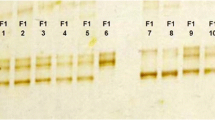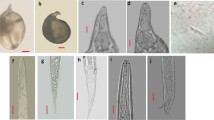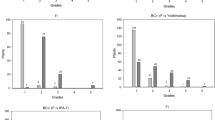Abstract
The possibilities of selecting virulence from a virtually avirulent root-knot nematode population towards resistance in wild potato have been investigated. Single egg masses of Meloidogyne chitwoodi, which had occasionally been produced on roots of resistant Solanum fendleri gave rise to eight lines after one generation on tomato. Five lines were able to circumvent completely the resistance of S. fendleri 93-114-12 resulting in a susceptible response similar to that of the control potato cv Nicola. Subsequently, a resistance test with other resistant genotypes of S. fendleri, S. bulbocastanum, S. stoloniferum and S. hougasii revealed that the virulent lines were also able to break through the resistance in most other species, but clear differences were noticed between the virulent lines. The results suggest a simple inheritance of virulence in M. chitwoodi towards resistance in S. fendleri. However, more virulence factors are involved to explain the differences on the other Solanum species between the virulent lines. The implications of the ease to select virulence with respect to the practical use of resistance in potato breeding and growing are discussed.
Similar content being viewed by others
References
Bakker J, Folkertsma RT, Rouppe van der Voort JNAM, De Boer JM, Gommers FJ (1993) Changing concepts and molecular approaches in the management of virulence genes in potato cyst nematodes. Annual Review of Phytopathology 31: 169-190
Berthou F, Ba-Diallo A, de Maeyer L and de Guiran G (1989) Caractérisation chez les nématodes MeloidogyneGoeldi (Tylenchida) de types virulents vis-à-vis du gène Mide la tomate dans deux zones maraîchéres au Sénégal. Agronomie 9: 877-884
Bost SC and Triantaphyllou AC (1982) Genetic basis of the epidemiologic effects of resistance to Meloidogyne incognitain the tomato cultivar Small Fry. Journal of Nematology 14: 540-544
Brown CR, Mojtahedi H and Santo GS (1989) Comparison of reproductive efficiency of Meloidogyne chitwoodion Solanum bulbocastanumin soil and in vitro tests. Plant Disease 73: 957-959
Brown CR, Mojtahedi H and Santo GS (1991) Resistance to Columbia root-knot nematode in Solanumssp. and in hybrids of S. hougasiiwith tetraploid cultivated potato. American Potato Journal 68: 445-452
Brown CR, Mojtahedi H, Santo GS and Austin-Phillips S (1994) Enhancing resistance to root-knot nematodes derived from wild Solanumspecies in potato germplasm. In: Zehnder GW, Powelson ML, Jansson RK and Raman KV (eds) Advances in potato pest biology and management (pp 426-438) APS press, St. Paul, USA
Brown CR, Yang C-P, Mojtahedi H and Santo GS (1996) RFLP analysis of resistance to Columbia root-knot nematode derived from Solanum bulbocastanumin a BC2 population. Theoretical and Applied Genetics 92: 572-576
Castagnone-Sereno P, Bongiovanni M and Dalmasso A (1994a) Reproduction of virulent isolates of Meloidogyne incognitaon susceptible and Mi-resistant tomato. Journal of Nematology 26: 324-328
Castagnone-Sereno P, Wajnberg E, Bongiovanni M, Leroy F and Dalmasso A (1994b) Genetic variation in Meloidogyne incognitavirulence against the tomato Miresistance gene: evidence from isofemale line selection studies. Theoretical and Applied Genetics 88: 749-753
Cook R and Evans K (1987) Resistance and tolerance. In: Brown RH and Kerry BR (eds) Principles and practice of nematode control in crops (pp 179-231) AP, New York, USA
Dickson DW and Strubble FB (1965) A sieving-staining technique for extraction of egg masses of Meloidogyne incognitafrom soil. Phytopathology 55: 497
Esbenshade PR and Triantaphyllou AC (1990) Isozyme phenotypes for the identification of Meloidogynespecies. Journal of Nematology 22: 10-15
Esmenjaud D, Minot JC, Voisin R, Bonnet A and Salesses G (1996) Inheritance of resistance to the root-knot nematode Meloidogyne arenariain Myrobalan plum. Theoretical and Applied Genetics 92: 873-879
Fargette M and Braaksma R (1990) Use of the esterase phenotype in the taxonomy of the genus Meloidogyne. 3. A study of some ‘B’ race lines and their taxonomic position. Revue de Nématologie 13: 375-386
Hawkes JG (1990) The potato. Evolution, biodiversity and genetic resources. Belhaven Press, London, UK, 259 pp
Gilbert JC and McGuire DC (1956) Inheritance of resistance to severe root knot from Meloidogyne incognitain commercial type tomatoes. Proceedings of the American Society of Horticultural Science 68: 437-442
Janssen GJW, Verkerk-Bakker B, Van Norel A and Janssen R (1996) Resistance to Meloidogyne hapla, M. fallaxand M. chitwoodiin wild tuber-bearing Solanumspp. Euphytica 92: 287-294
Janssen GJW, Van Norel A, Verkerk-Bakker B and Janssen R (1997a) Intra-and inter-specific variation of root-knot nematodes, Meloidogynespp., for resistance from wild tuber-bearing Solanumspp. Fundamental and Applied Nematology 20: 449- 457
Janssen GJW, Van Norel A, Janssen R and Hoogendoorn J (1997b) Dominant and additive resistance to the root-knot nematodes Meloidogyne chitwoodiand M. fallaxin Central American Solanumspecies. Theoretical and Applied Genetics 94: 692-700
Janssen GJW, Van Norel A, Verkerk-Bakker B, Janssen R and Hoogendoorn J (1997c) Introgression of resistance to root-knot nematodes from wild Central American Solanumspecies into S. tuberosumssp. tuberosum. Theoretical and Applied Genetics 95: 490-496
Jarquin-Barberena H, Dalmasso A, de Guiran G and Cardin MC (1991) Acquired virulence in the plant parasitic nematode Meloidogyne incognita. 1. Biological analysis of the phenomenon. Revue de Nématologie 14: 299-303
Keen NT (1990) Gene-for-gene complementarity in plant-pathogen interactions. Annual Review of Genetics 24: 447-463
Kort J, Ross H, Rumpenhorst HJ and Stone AR (1977) An international scheme for identifying and classifying pathotypes of potato cyst-nematodes Globodera rostochiensisand G. pallida. Nematologica 23: 333-339
Lasserre F, Gigault F, Gauthier JP, Henry JP, Sandmeier M and Rivoal R (1996) Genetic variation in natural populations of the cereal cyst nematode (Heterodera avenaeWoll.) submitted to resistant and susceptible cultivars of cereals. Theoretical and Applied Genetics 93: 1-8
Mojtahedi H and Santo GS (1994) A new host of Meloidogyne chitwoodifrom California. Plant Disease 78: 1010
Müller J (1992) Detection of pathotypes by assessing the virulence of Heterodera schachtiipopulations. Nematologica 38: 50-64
Netscher C (1977) Observations and preliminary studies on the occurrence of resistance breaking biotypes of Meloidogynespp. on tomato. Cahiers ORSTOM Series Biologie 11: 173-178
Prot JC (1984) A naturally occurring resistance breaking biotype of Meloidogyne arenariaon tomato. Reproduction and pathogenicity on tomato cultivars Roma and Rossol. Revue de Nématologie 7: 23-28
Riggs RD and Winstead NN (1959) Studies on resistance in tomato to root-knot nematodes and on the occurrence of pathogenic biotypes. Phytopathology 33: 716-724
Roberts PA (1995) Conceptual and practical aspects of variability in root-knot nematodes related to host plant resistance. Annual Revue of Phytopathology 33: 199-221
Roberts PA and Thomason IJ (1989) A review of variability in four Meloidogynespp. measured by reproduction on several hosts including Lycopersicon. Agric Zool Rev 3: 225-252
Roberts PA, Dalmasso A, Cap GB and Castagnone-Sereno P (1990) Resistance in Lycopersion peruvianumto isolates of Migene- compatible Meloidogynepopulations. Journal of Nematology 22: 585-589
Rouppe van der Voort JNAM, Janssen GJW, Overmars H, Van Zandvoort PM, Van Norel A, Scholten OE, Janssen R and Bakker J (1998) Development of a PCR-based selection assay for root-knot nematode resistance (Rmc1) by a comparative analysis of the Solanum bulbocastanumand S. tuberosumgenome. Euphytica (in press)
Sauer MR and Giles JE (1959) A field trial with a root-knot resistant tomato variety. Australian Irrigation Research Station Technical Paper 3: 1-10
Simms EL (1996) The evolutionary genetics of plant-pathogen systems. Bioscience 46: 136-145
Triantaphyllou AC (1987) Genetics of parasitism on plants. In: Veech JA, Dickson DW (eds) Vistas on Nematology (pp. 354- 363). Society of Nematology Inc, Hyattsville, USA
Van der Beek JG, Poleij LM, Zijlstra C, Janssen R and Janssen GJW (1998) Variation in virulence within Meloidogyne chitwoodi, M. fallaxand M. haplaon Solanumspp. Phytopathology (in press)
Veremis JC and Roberts PA (1996) Relationships between Meloidogyne incognitaresistance genes in Lycopersicon peruvianumdifferentiated by heat sensitivity and nematode virulence. Theoretical and Applied Genetics 93: 950-959
Author information
Authors and Affiliations
Rights and permissions
About this article
Cite this article
Janssen, G.J., Scholten, O.E., van Norel, A. et al. Selection of virulence in Meloidogyne chitwoodi to resistance in the wild potato Solanum fendleri. European Journal of Plant Pathology 104, 645–651 (1998). https://doi.org/10.1023/A:1008625404330
Issue Date:
DOI: https://doi.org/10.1023/A:1008625404330




